Total visits: 101607,Daily visits 146; Instruments: 108.
Total visits: 101607,Daily visits 146; Instruments: 108.
2025-09-23 Technical application browse 122

Mass spectrometry (MS) ionizes samples and measures the mass-to-charge ratio (m/z) of the resulting ions. With the integration of mass spectrometers, computer technology, and software, the application of MS has become increasingly broad. The diverse sample types that can be analyzed and the range of information that can be obtained have enabled MS to penetrate numerous research fields, including chemistry, biochemistry, pharmacy, medicine, and many related scientific fields.
Application of Mass Spectrometry in Proteomics
MS has become a powerful tool in proteomics research, enabling precise determination of the molecular weight and sequence of peptides and proteins. In tandem mass spectrometry, fragmentation of peptides and proteins provides sequence information, which is used for protein identification and the identification and localization of post-translational or other covalent modifications.
• Protein Identification by Mass Spectrometry
Mass spectrometry has become the predominant method for protein identification. There are two main mass spectrometry-based protein identification methods: de novo sequencing and peptide mass fingerprinting (PMF) database searching. Ultimately, proteins are identified computationally from captured mass spectral peaks, with each peak theoretically representing a peptide fragment ion. • Mass spectrometry protein quantification
Proteomics research often requires understanding protein expression levels. The emergence and development of mass spectrometry technology has enabled more reliable and dynamic methods to analyze differential protein expression. Quantitative proteomics can be categorized into relative quantification and absolute quantification. Relative quantification aims to investigate differences in proteome expression under different conditions and primarily includes stable isotope labeling and label-free quantification. Absolute quantification involves determining specific protein expression levels. Common methods for protein quantification include iTRAQ (isotope labeling for relative and absolute quantification), SILAC (stable isotope labeling of amino acids in cell culture), ICAT (isotope-coded affinity tag), and label-free quantification.
• Mass spectrometry analysis of post-translational modifications
Post-translational modifications (PTMs) are chemical alterations in protein structure, typically catalyzed by substrate-specific enzymes. There are many types of PTMs, including phosphorylation, acetylation, and glycosylation. Mass spectrometry is considered a key technology for protein modification analysis because it can provide general information about protein modifications without requiring prior knowledge of the location of the modification sites. Top-down, mid-down, and bottom-up are the three main strategies for mass spectrometry-based PTM analysis.
Mass Spectrometry Analysis in Metabolomics
Metabolites are small molecules that participate in general metabolic reactions and maintain cellular maintenance, growth, and normal function. Metabolomics is the identification and quantification of all metabolites in a biological system. Mass spectrometry (MS) and nuclear magnetic resonance (NMR) are commonly used small molecule analysis tools in metabolomics. Mass spectrometry-based metabolomics studies the effects of drugs, toxins, and various diseases on metabolite levels, tracing metabolic pathways and measuring metabolic flux.
Mass Spectrometry Imaging
Mass spectrometry imaging (MSI) is a technique for visualizing the spatial distribution of molecules. Mass spectra can be acquired from micron-scale regions of a surface, converting the lateral distribution of compounds on the surface (e.g., microelectronic devices, tissue sections) into images that can be correlated with optical images. Some common ionization techniques include DESI imaging, MALDI imaging, and secondary ion mass spectrometry imaging (SIMS imaging).
Mass Spectrometry in Glycomics
Glycosylation is one of the most important post-translational modifications (PTMs), with over 50% of mammalian proteins being glycosylated. Glycomics, a branch of glycobiology, aims to characterize the structure and function of the glycome. Mass spectrometry-based glycomics is widely used to analyze the glycan moieties of oligosaccharides, glycosaminoglycans, and glycoproteins, proteoglycans, and glycolipids. Matrix-assisted laser desorption ionization (MALDI) and electrospray ionization (ESI) are commonly used for glycoconjugate analysis. Mass spectrometry can be used as a standalone technique or coupled with separation methods such as high-performance liquid chromatography (HPLC) and capillary electrophoresis (CE).